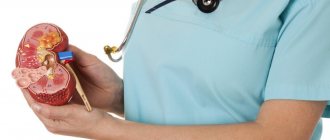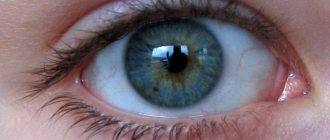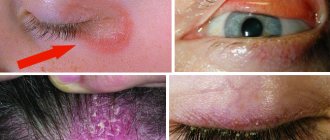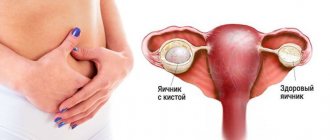17.08.2017
Diseases of the genitourinary system | Uterus
Cyclicity is the law of Life. The cosmos and our body, as its integral part, live in harmony with it. An example of this is the cycles of the female reproductive system. Cyclicity, despite its apparent repetition, is a tool of evolution, movement, and development. “Fixation” or “vicious circle”, on the contrary, serves as an obstacle to the flow of life. And then in one or another part of the body where such stagnation occurs, formations unforeseen by nature can develop. These include ovarian cysts, which will be discussed.
A cyst is a benign tumor , similar to a “ball” on a stalk with thin walls ranging in size from millimeters to tens of centimeters, filled with liquid with various impurities. If this “ball” is small, then without a special examination we will not know about it, because It does not cause any inconvenience to us or nearby organs. Sometimes the cyst disappears on its own without treatment. But more often, such a “ball” begins to grow due to the liquid accumulating in it. And at a certain size, due to compression of neighboring organs, the risk of inflammation or rupture of the membrane, it requires increased attention to itself. Therefore, it is recommended not to leave a discovered cyst to its own devices, but to observe it and, if necessary, treat it.
There are different types of cysts: follicular (73%), corpus luteum cysts (5%), theca lutein (2%), endometrioid (10%), paraovarian (10%). There are many names, but the essence is the same: the transformation of normal, physiological cyclicity (for example, the process of follicle maturation in the ovary) into “cyclicity” (into a follicular cyst).
This transformation is based on a malfunction in the functioning of the regulator of cyclical (and not only) processes in our body - the hormonal system against the background of stagnation in the pelvic area. Hence the essence of cyst treatment: eliminate stagnation and improve the functioning of the hormonal system, i.e. return the body to the harmonious, progressive movement of life. Questions about how to do this and whether it is possible to do without surgery and treatment with hormones will be answered in each specific case by a doctor at our clinic, based on the results of the examination.
Classification of ovarian cysts
There are several forms of ovarian cysts:
- Follicular cyst - formed from the follicle in which the egg matures. Normally, a mature follicle bursts and a formed egg emerges from it into the abdominal cavity. This process is called ovulation. If the follicle does not open and continues to grow, then they speak of the development of a follicular cyst.
- Serous (simple) cyst . It is a bubble that forms from the serous (outer) tissue of the ovary. The bubble is filled with a clear liquid.
- Corpus luteum cyst . It is an accumulation of fluid at the site of a burst follicle.
- Paraovarian cyst . Formed from the epididymis, localized between the ovary and the fallopian tube.
Causes of ovarian cysts
The exact causes of the appearance of cysts in the ovaries are unknown, but there are a number of factors that can trigger the development of the disease.
These include:
- frequent surgical interventions on the reproductive organs, abortions;
- diabetes mellitus, obesity;
- chronic inflammatory diseases of the female reproductive organs – endometriosis, salpingoophoritis, adnexitis, STDs and a number of others;
- diseases of the thyroid gland and other endocrine organs;
- hormonal imbalances in a woman’s body;
- early (before 11 years) onset of menstruation, ovarian dysfunction, disruption of the follicle maturation process, lack of ovulation;
- relapses of previously treated cysts.
In addition, each type of cyst has its own causes of origin:
- corpus luteum cyst and follicular cyst are formed as a result of hormonal imbalance in the body;
- dermoid cyst – is congenital;
- multiple cysts (PCOS) – occur against the background of other female diseases.
The main risk factors that can lead to the development of ovarian cysts are:
- suffered multiple abortions;
- smoking;
- age up to 50 years;
- C-section;
- undergone surgery to remove appendicitis, gallbladder;
- cycle disorders, which are accompanied by painful menstruation and prolonged uterine bleeding;
- use of oral hormonal contraceptives;
- use of an IUD;
- some somatic diseases;
- chronic inflammatory diseases of the uterus and its appendages;
- benign tumors of the cervix.
When is conservative treatment of ovarian cyst relevant?
Conservative treatment is acceptable only for functional ovarian cysts (follicular or corpus luteum cysts). These are so-called hormonal cysts, which can be treated by normalizing a woman’s hormonal levels.
At the Yusupov Oncology Clinic, with well-chosen drug treatment, functional cysts disappear after three months. Throughout your stay in the clinic, doctors monitor the dynamics of the treatment used.
The best hospital in Moscow provides conservative treatment for ovarian cysts, using an integrated approach to pathology. Qualified doctors prescribe anti-inflammatory, antifungal, antimicrobial and hormonal drugs. Antibiotics for ovarian cysts are used to destroy pathogenic microflora, which may be the main cause of the development of the disease or a factor that impedes rapid and effective treatment. Along with injections and tablets for ovarian cysts, suppositories are used, which are vaginal and rectal (inserted into the rectum). Suppositories are used due to the fact that one of the factors causing cysts is the inflammatory process in the pelvis. They contain enzymes that dissolve adhesions, blood clots, blood clots and pus. They are administered rectally, the dose and duration of treatment is determined by the doctor individually for each patient.
In case of hormonal imbalance (excess estrogen and lack of progesterone), hormonal vaginal suppositories are used. The active ingredient is progesterone - a substance that normalizes hormonal levels, reduces cystic formations, and also reduces the risk of complications.
Suppositories with lactobacilli are used to restore vaginal microflora after treating inflammation with antibiotics and vaginal suppositories.
Immunomodulators in the form of rectal suppositories are used to combat immune system disorders that can lead to cystic formations.
Symptoms of ovarian cysts
Most often, the disease is practically asymptomatic. A woman can only be bothered by nagging, mild pain in the lower abdomen. The cyst may shrink and resolve on its own over several menstrual cycles.
Only sometimes the formation of a cyst in the ovaries is accompanied by the following symptoms:
- sharp and severe pain in the lower abdomen;
- pain in the vagina, bloody discharge from the genitals;
- heaviness in the pelvic area;
- painful periods;
- disturbance of urination and defecation caused by pressure of the cyst on the bladder or rectum;
- nausea, vomiting that occurs after sexual intercourse or intense exercise;
- cycle disruption.
If the following symptoms appear, you should consult a doctor:
- increase in body temperature to 38 degrees and above;
- dizziness, weakness, loss of consciousness;
- a lump that can be felt by palpating the abdominal cavity;
- heavy discharge during menstruation;
- causeless weight loss;
- increase in abdominal volume;
- high blood pressure;
- severe thirst, increased diuresis;
- male pattern hair growth.
3. Symptoms of the disease
A simple kidney cyst usually does not cause any symptoms. Most often, the doctor finds this disease during an ultrasound or computed tomography scan prescribed for other reasons. However, a kidney cyst may
:
- Cause pain in the side, back (lower back) or abdomen in the kidney area if it increases and begins to put pressure on other organs;
- Bleeding (a sign of a cyst may be blood in the urine);
- Be infected and cause fever, chills and other signs of infection;
- Harm your kidney function (this is rare).
A simple kidney cyst may be associated with high blood pressure, but the reason for this relationship has not been established to date.
About our clinic Chistye Prudy metro station Medintercom page!
Diagnosis of ovarian cysts
Diagnosis of the disease includes the following steps:
- taking an anamnesis, questioning and external examination of the patient (the doctor is interested in how long ago the pain in the lower abdomen appeared, how often it occurs, whether it is referred to other places, whether the woman has concomitant diseases of the genital organs, whether she had an abortion, when her first period came and etc);
- gynecological examination with mandatory two-handed examination to determine the location and size of the ovaries, uterus, cervix, assessment of their current condition (pain, mobility, and so on);
- transvaginal ultrasound of the pelvic and abdominal organs - performed using a special sensor, which is inserted into the vagina; using this technique, the presence and location of cysts are determined, differential diagnosis is carried out from benign and malignant neoplasms, and the type of cyst is determined;
- Laparoscopy is an additional diagnostic method, with which it is possible to obtain a clear image of the cyst; the study is carried out using a special device, an endoscope, which is inserted into the abdominal cavity through a special small incision.
Treatment of ovarian cysts
When choosing treatment tactics, the doctor takes into account the type of cyst, its size, the risk of becoming malignant, as well as the woman’s age and her intention to have children in the future.
For women of reproductive age, surgical removal of an ovarian cyst is performed as a last resort, since during the operation not only the cyst is removed, but also the entire ovary along with the appendage.
Conservative treatment of the disease is possible only when the causes of the cysts are functional in nature. In addition, the cyst should not have a tendency to suppuration, rupture of the capsule and other complications.
In all other cases, surgical removal of the cyst is indicated. Nowadays, removal is most often performed by laparoscopy. This operation is more effective, but at the same time minimally invasive and gentle, which reduces the risk of developing postoperative complications.
Folk remedies for ovarian cysts
Although hormonal and drug treatment can effectively overcome ovarian cysts, they do not help in all cases. In addition, such treatment is often accompanied by a variety of side effects, and therefore many people think about alternative methods of treatment. It is quite possible to cure a cyst using folk remedies at home, which has long been confirmed in practice by more than one generation. This article will highlight the most effective traditional methods of treatment.
Dandelion root
Dandelion turns out to be an effective remedy in the fight against many ailments, including ovarian cysts. For preparation you need dried or fresh chopped root. One teaspoon of the root is poured with boiling water (one glass will be enough), covered and left for no more than a quarter of an hour. Subsequently, filtering is carried out. The tincture is taken no more than twice a day, one-third of a glass - in the morning on an empty stomach and in the evening, a couple of hours after dinner. Treatment lasts five days before each period.
Recipe for tinctures of three herbs
Each of the decoctions is prepared according to the same recipe: a teaspoon of chopped and dried herbs is poured with boiling water, further infused (20 minutes will be enough) and filtered. The effectiveness of this treatment option depends entirely on the following order of administration:
- 1 week - drink one third of a glass of boron uterus decoction three times a day an hour before eating;
- Week 2 – use a decoction of red brush;
- Week 3 – use wintergreen decoction.
Decoctions are used after menstruation. As soon as your period has passed, you can repeat the above course. For more effective treatment using this method, you can add a spoonful of honey.
Burdock juice
For this remedy, you need to pass the burdock leaves through a juicer. The resulting juice must be stored in a glass container in the refrigerator for no more than three days.
You need to consume the juice according to the following scheme:
- the first days after the end of menstruation - one teaspoon before eating a couple of times a day;
- on the third and fourth days, take one teaspoon three times a day;
- From the fifth to the first day of menstruation - a tablespoon three times a day.
When menstruation occurs, it is recommended to interrupt treatment. Once they are completed, an ultrasound can be done to check the result. If necessary, treatment should be continued for two or three cycles.
Chaga mushroom
Chaga mushroom is an excellent healing agent in the fight against ovarian cysts. In our herbal pharmacy you can purchase this mushroom in powder form, and then make tinctures based on it. It should be consumed for three months, taking breaks during menstruation.
Complex collection of tinctures
This folk remedy includes the following components:
- juice from aloe leaves – 300 ml;
- liquid honey – 300 ml;
- viburnum juice – 200 ml;
- Befungin – 100 ml;
- calendula-based tincture – 100 ml;
- plantain tincture – 100 ml;
- tincture based on celandine – 100 ml;
- wormwood – 100 g;
- vodka – 500 ml.
All components must be placed in a clean three-liter jar. Crushed wormwood and liquid honey are placed at the bottom, only then the remaining components. All this is thoroughly mixed, the vessel is tightly closed with a lid and stored in a dry place for two weeks. After the expiration date, it is necessary to filter, and then hide the jar with the resulting medicine in the refrigerator.
This medicine is taken one teaspoon before meals three times a day. Taking into account breaks during menstruation, treatment lasts within three to four months.
It is important to note that if you suspect any type of cancer, it is recommended to exclude aloe juice from the composition, since this plant is a very powerful biological stimulant.
Green walnuts
To prepare this tincture, you need to rinse the fruits under hot water and cut each nut into several slices (eight will be enough). The slices need to be placed in a liter jar so that it is a quarter full. After this, you need to fill it to the brim with vodka (alternatively, you can resort to alcohol), close the lid tightly and put it in a dark and cool room for four weeks. During this time, the tincture will take on a dark shade.
After this, you need to strain the medicine, pour it into a glass container and put it in the refrigerator. Take a tablespoon three times throughout the day before meals. Taking into account breaks for menstruation, the course of treatment lasts from three to four months.
Treatment of Baker's cyst of the knee joint with folk remedies
Treatment of Baker's cyst with folk remedies involves the use of compresses from tinctures and decoctions. Use the golden mustache tincture that we talked about earlier - apply the compress up to twice a day, and also take the product internally according to the already indicated scheme. A compress of burdock and celandine leaves helps remove the cyst just as well. Grind the leaves, steam them and apply this mixture to the knee where the problem is observed. An effective recipe is also prepared from a mixture of grated aloe (1 tsp), a teaspoon of lemon juice, and one gram of streptocide. All compresses must be done regularly to achieve a pronounced effect.
Prevention of ovarian cysts
The main measures to prevent the disease are:
- refusal of uncontrolled use of oral contraceptives - only the attending physician can prescribe drugs of this group, based on the individual characteristics of each woman’s body, otherwise a number of serious complications may develop;
- use of barrier contraception during sexual intercourse;
- compliance with the rules of intimate hygiene;
- refusal of promiscuity;
- timely treatment of diseases that can provoke the development of ovarian cysts;
- regular sanitation of foci of chronic infection in the body;
- refusal of a sedentary lifestyle, which leads to stagnation of blood in the pelvic organs, which can provoke the formation of cysts;
- avoiding thermal procedures (visiting saunas, baths, solariums, sunbathing);
- refusal of abortion;
- rejection of bad habits;
- weight control, obesity prevention;
- Seeing a doctor when the first suspicious symptoms appear will help you start treatment in a timely manner and improve the prognosis of the disease.
Treatment of tonsil cysts
Treatment of cysts can be either conservative or surgical. Often, specialists first prescribe effective drug therapy to relieve inflammation and prepare the patient for surgery. Conservative treatment of a cyst will not reduce its size, but can stop the active growth of the tumor and prevent complications. Treatment tactics should be selected by a competent specialist based on medical history, diagnosis and professional examination.
Conservative therapy for tonsil cysts includes the following measures and procedures:
- gargling with herbal decoctions, antiseptic solutions that disinfect tissues and have an anti-edematous and anti-inflammatory effect;
- physiotherapy: ultraviolet irradiation, massage, ultrasound - physiotherapeutic treatment methods are used to increase blood supply to tissues in the area where the tumor is located, to ensure lymph outflow;
- pumping out pus using hardware methods, which makes it possible to stop the development of the infectious process and the spread of infection to surrounding tissues;
- injection rinsing of the tonsils with anti-inflammatory drugs and antiseptics to cleanse plaque and purulent contents;
- strengthening the immune system with multivitamin complexes and immunostimulants;
- giving up bad habits that contribute to traumatization of the tonsils and the preservation of the chronic inflammatory process.
Some specialists practice opening the cyst and pumping out its contents. But, as a rule, the therapeutic effect does not last long and the tumor is filled with fluid again. Therefore, if the cyst has not disappeared after several weeks of active medical therapy, it is better to remove it surgically.
Where can I buy
You can get folk remedies and ingredients for treating cysts on the pages of our online store “Russian Roots”. Couriers will deliver the ordered goods to Moscow and other localities in the capital region. In the case of other regions, delivery is carried out by mail. You can also select the necessary ingredients or folk remedies in our Moscow herbal pharmacies.
Attention! All materials published on our website are protected by copyright. When re-publishing, attribution and a link to the original source are required.











